#north america insect guide
Photo
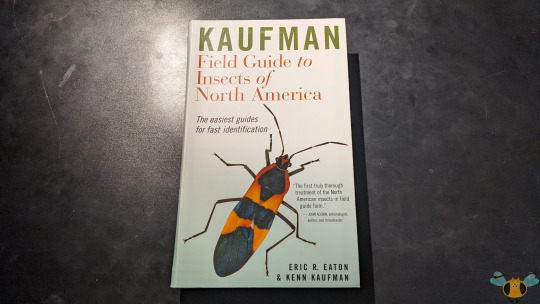
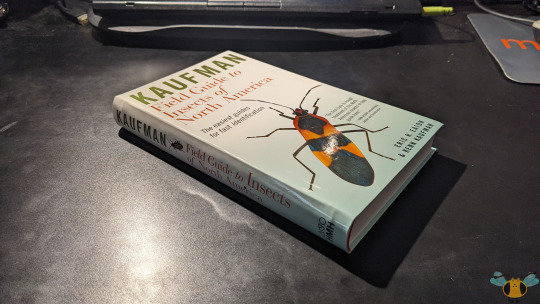
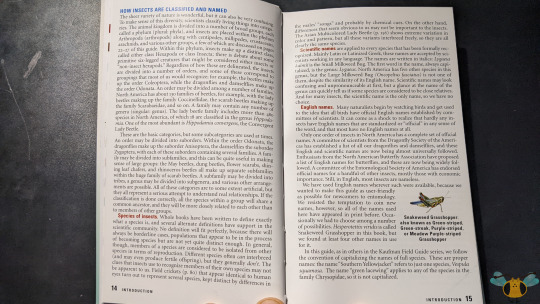
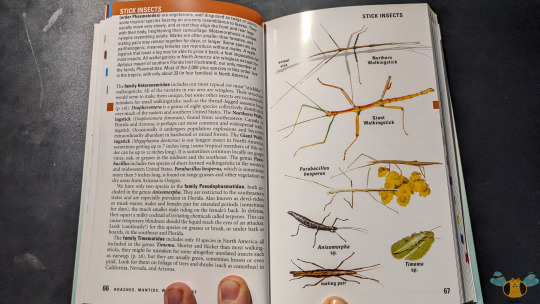


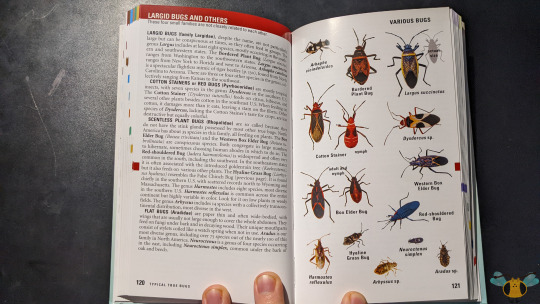
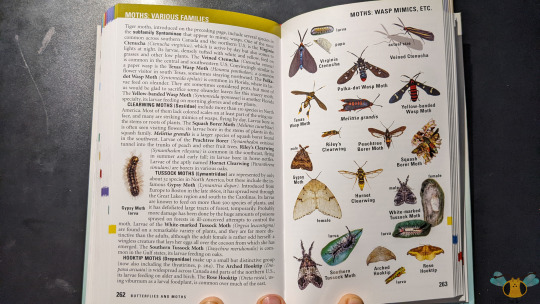


Kaufman Field Guide to Insects of North America, by Eric R. Eaton and Kenn Kaufman
I’ve added a new field guide to my growing collection of insect identification resources. This book was recommended to me after I picked up the Audubon Butterfly guide, and I have to say, I quite enjoy this book and it will be accompanying me on outdoor daylong bug hunts alongside the Audubon books. If you’re looking for something a bit more general, perhaps as an entry resource to help you catalogue and identify insects as a hobby, this book is a great starting point. The format of the book is mostly consistent with Pictures 4-8: key information on the left side of the book and pictures of insects on the right. The information is simple to understand and very articulate, highlighting crucial information that can help you sort insects into their different orders and families. For example, in the Beetle section, there are separate pages that would highlight the key characteristics that make each insect special which in turn allows a simple identification for each Beetle such as what makes a Leaf Beetle and a Longhorn Beetle. Many prominent species are highlighted in the field guide, but mostly those living in Canada and the USA. Of course, the guide can’t cover every insect specie, but the descriptions given are to the point you may recognize some of the more common species included. For something more technical, you many have to turn to another guide or consult an internet resource.
The insect imagery in the book is quite good, really aiding the text descriptions. I give many thanks to the contributing photographers of this guide and I wish that there were sections that would showcase larger insect pictures and diagrams. It would definitely help with the author’s goal of “naked eye identification” and to highlight some of the more rare insects, insects that look similar to other insects, and insects that (while presumed common) aren’t part of common knowledge. It’s for this reason that I highlight Picture 6 which documents Mantidflies (Mantispids). These are not Mantids or Flies and they can resemble Wasps, but they are in fact Neuropterans! It’s not something everyone would know and thus I think it should receive a bit more attention. A little bit of information can make the difference between knowing which insects to avoid and which look fearsome but are harmless, just like the Mantidflies. As well, finally a visualization of Snakeflies on this blog! Finally, what I enjoyed most about this field guide was the passion and love for insects on display in the writing. The people who wrote and contributed to this book clearly love these creatures and want to share with others why insects are important, what we can learn from them and how they impact Earth and our lives. All this is presented in a way that (aside from a few scientific or technical terms) is easily digestible and readily applicable.
To all those looking to create a hobby based on insects, learn the basics of insect identification or if you have a real passion for insects, I do recommend this book. I’ll be using it where I can, and until then it will stay with the other books I reference lined up on the bookshelf. To conclude, there are sections in the book on Arachnids and non-insect hexapods which I also appreciate, if only to highlight the difference between them and insects.
For additional insect literature, you may visit the Blog Resources page.
#jonny’s insect catalogue#insect field guide#kaufman field guide to insects of north america#field guide to insects of north america#north america insect guide#field guide#insect identification guide#amateur insect guide#insect pictures#insect facts#insect identification#entomology#invertebrates#arthropods
6 notes
·
View notes
Text
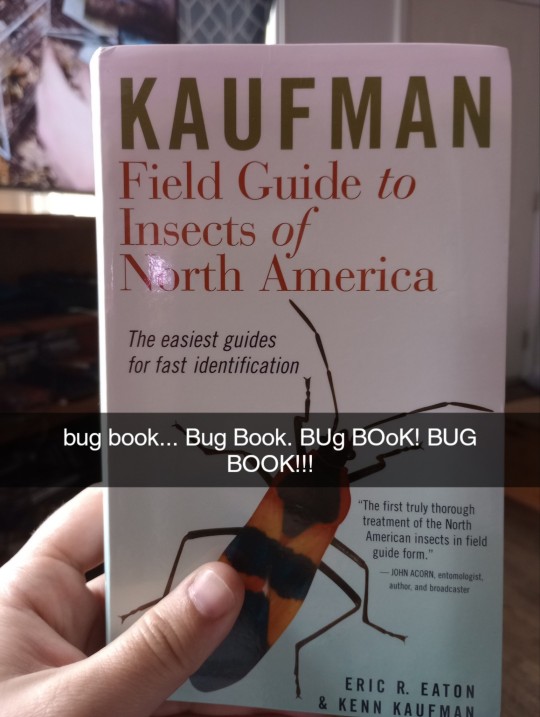
#book blog#bug field guide#bug book#bugs#insects#invertebrates#arthropods#field guide#field guide to insects of north america
8 notes
·
View notes
Text

Birthday book & bookmark~ 🦋
2 notes
·
View notes
Photo

National Audubon Society Field Guide to Insects and Spiders: North America
Fresh Off the Boat: "Good Morning Orlando"
#National Audubon Society Field Guide to Insects and Spiders: North America#fresh off the boat#fotb#constance wu
17 notes
·
View notes
Note
Could I mayhaps know what's the name of that arachnid field guide you have 0//0 it looks really pretty and I have. A thirst for all arachnid related field guides and biology books, love those critters
The Golden Guide to Spiders and their Kin! There were lots of them, originally made in the 60's or 70's I believe, and they used to still be so common when I was a kid - still in print, and sold for just a couple dollars everywhere - I thought everybody had a few! But now they seem to be forgotten.
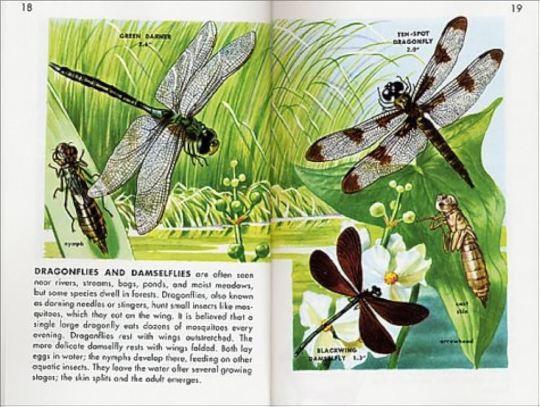
I had the spiders one, insects one and "seashores" one (mantis shrimps and nudibranchs!!) before I could even read, just looking at the pictures all day. As I learned to read they were how I learned concepts of taxonomy and ecology, why I knew what a "parasitoid" was in first grade and I'd talk constantly about insects that aren't really RARE, but culturally most people never heard about. These books made things like velvet ants, bolas spiders and hairy millipedes seem to me like knowledge as ordinary as dogs and cats.

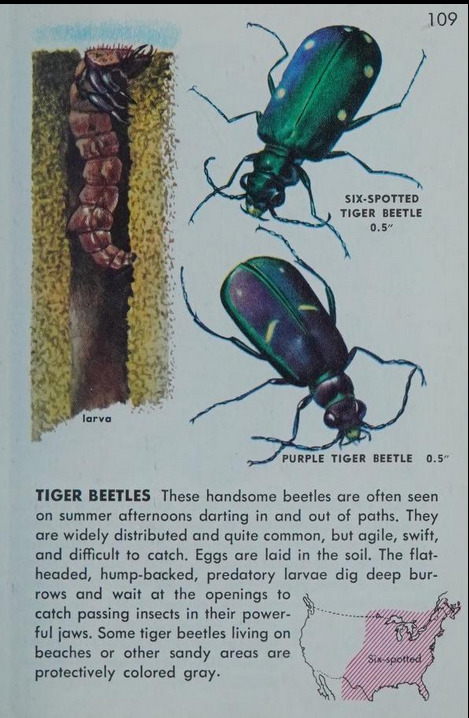
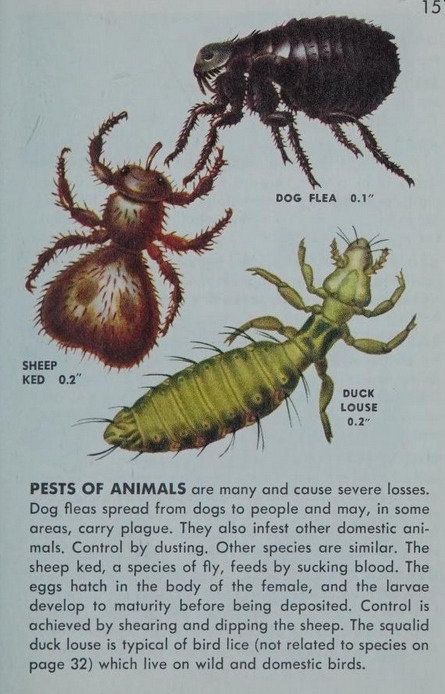
That "pests of animals" page in particular is why I knew there were wingless parasitic flies, and I thought that was so cool, I was obsessed with "SHEEP KED" for my entire childhood. This bug that nobody ever heard of when I mentioned it, but was at one time deemed worthy of inclusion in an everyday field guide.
And they include "duck louse" as an animal pest you're expected to encounter. Sheep and duck parasites?!.....Oh, right! When these books first published, it was still commonplace for almost everyone to have experience with farm animals. Most people at least had grandparents or aunts and uncles with a farm they might visit and help out on. Of course they would encounter sheep and duck parasites.
I think they still publish these, actually, I'm sure I still saw them in Barnes and Noble only a few years ago, but it's remarkable what a different America they were made under. My old copy even recommended DDT to control bed bugs....they did eventually edit that out in newer editions.

Some of their attitudes may be outdated here and there, and they're only intended for North American wildlife, but I think the golden guides might still be perfect introductions to their topics for anyone, anywhere of any age really?? They're such well-balanced overviews so densely packed with just the most essential information about each organism.
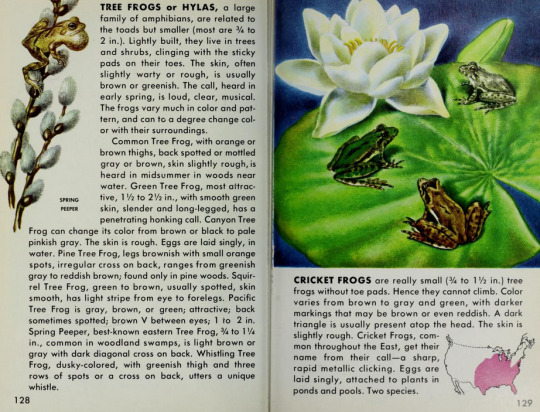
....Did people really ever just call tree frogs "hylas?!" It's one of their genus names, but was it also used as a common name anywhere? That's a cute idea. Maybe it was, briefly, so at some point to someone there was a concept of Frog, Toad, and Hyla?
141 notes
·
View notes
Text
BOTD: Black Phoebe
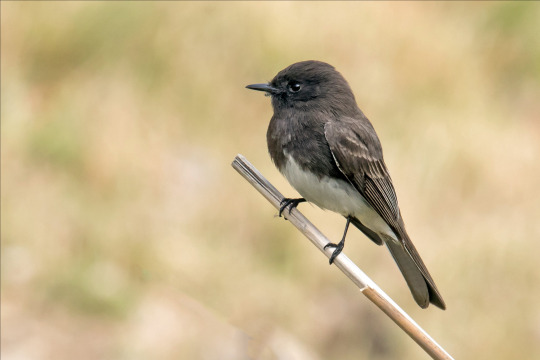
Photo: Mick Thompson
"The sharp whistled call of the Black Phoebe is a typical sound along creeks and ponds in the southwest. The birder who explores such areas is likely to see the bird perched low over the water, slowly wagging its tail, then darting out in rapid flight to snap up an insect just above the water's surface. Related to the familiar Eastern Phoebe of eastern North America, this species has a much wider range, living along streams from California to Argentina."
- Audubon Field Guide
#birds#black phoebe#birds of north america#north american birds#phoebes#flycatchers#tyrant flycatchers#passerines#birds of the us#birds of mexico#birds of central america#birding#birdblr#birblr#bird watching#bird of the day#Sayornis nigricans
97 notes
·
View notes
Text
I have already been using the website bug guide pretty much exclusively for my bug information because it uses a very standardized set of information that isn’t usually biased towards a region, and I know about the website macroinvertebrates as well but I’ve been warned it has less generalized information/photos and more Northern usa specific content than is applicable to my southern location, but does anybody know of any other really good online sources of aquatic insect based information?
I’d also appreciate literature recommendations. My usual go to book was the aquatic insects of North America book by Merritt et al, but l’ve kinda lost my access to it via graduating college. I can’t remember which edition i had access to. I’m trying to restore my reference abilities for identification and detailed info.
24 notes
·
View notes
Text

A Field Guide to the Insects of America North of Mexico - Peterson Field Guide Series hardcover, 1970.
8 notes
·
View notes
Note
Where do you learn all these care specifics and scientific names and such? I've kept lots of critters (2 madagascar hissing roaches for a few years, some wild-caught adult grasshoppers and katydids for a few months, some mealworms into adulthood, etc) but I never knew stuff like what specific diseases they can catch and how to check, or how to tell different species of grasshoppers or whatever apart. Did you study this in college or just read up on things on your own? When I try to look up stuff like cockroach care I always end up with a million "how to kill nasty evil roaches because everyone hates them" articles.
I've been identifying bugs and using scientific names since I was little, so the years of experience helps, but there are many very accessible sources to help make learning about bugs easier!
I started with a field guide a lot like this, although some of the more basic ones don't have even half of the things you could find (just the more common ones). good field guides should also have scientific names, so you can learn those alongside the common names. scientific names are often much more helpful than the common names since those can change with region and language, but also because many bugs just don't have a common name.
if you happen to be in the US or Canada, BugGuide is a very useful resource where you can ask ID or look at other's submissions. obviously it's fairly limited by range, but has some very nice records and helpful experts.
iNaturalist is also a very helpful tool. it's fun to explore your local critters as well as those all around the world with the map, and you can get pretty decent IDs from the community (though often non-experts and the AI identifier can both be very wrong).
various forums and social media are also great for talking to other keepers and learning about bugs in captivity from them. as much as I hate it, Instagram has a nice population of bug keepers and just chatting with them can give you a lot of helpful tips and strategies.
79 notes
·
View notes
Note
Tips for identifying bugs? I do not live in america or am one
I've been busy but I'd like to put together a decent supplementary guide to TYPICAL arthropod body-shapes by phylogenetic group, to help people try to narrow down their searches regardless of where they are in the world.
However this might take me a while because I can't think of a good way to NOT need to make my own illustrations for it, and it's only half the battle anyways
You'll also need an insect and/or arachnid identification guide book for your region! Some guide books list noteable characteristics for phylogenetic groups, so you might not even need to wait on me to draw all that haha. I can't say I'm familiar enough to recommend any authors or publishers though, sorry.
There are probably also websites for identifying bugs outside of North America, but alas, I am nkt familiar with them so I cannot recommend any
20 notes
·
View notes
Text
I dont see enough advice for beginners in the vulture culture tag, so I figured id share some links and resources ive found in my past few years of experience and research
quick disclaimer: this will be more focused on bone cleaning and wet specimens because those are my areas of interest and therefore what I feel the most comfortable giving advice on
if you specialize in pelts or taxidermy feel free to add on your advice or resources!
the migratory birds treaty - a must read if you're in north america
birds that are exempt
places for tips/advice:
mickeyalicekwapis.com - has great blog posts from a professional taxidermist. covers everything from basic advice to ethics to advice on starting your own business
taxidermy.net - the og forum for taxidermy and bone cleaning advice. ive found questions answered here that I havent been able to find answered anywhere else on the internet. the members of this forum are like the old gods of vulture culture
r/vultureculture, r/taxidermy, r/bonecollecting, and r/wetspecimens - the reddit community can be kind of toxic but ive found some great advice and friendly people here. you also dont need an account to browse which is a plus
I also recommend @earthenremains' pinned post for some great articles and info on laws. in general dont be afraid to ask myself or someone else in the vulture culture community if you have more questions or need advice! most people will be happy to help if they can
guides:
wet preservation:
wet specimens by mickeyalicekwapis
useful thread on wet specimens
wet specimens: important note about formalin
more info on wet preservation
bones:
bone cleaning
bone cleaning guide from a forensics doctor
how NOT to clean bones
bone whitening by @roadkillandcrows
bone cleaning masterlist
taxidermy/pelts:
skinning guide part 1 and part 2 by @blackbackedjackal
face shaping guide by @blackbackedjackal
general:
buyers guide by @blackbackedjackal
buyers/sellers guide by @earthenremains
places to buy bones, taxidermy, wet specimens, and vulture culture art:
skullstore.ca - can be pricey if you're outside Canada or the USA but these guys are extremely reputable and have a pretty insane range of oddities
darlingdeadadorments.com - some of the most beautiful jewellery and pre-made displays ive ever seen
pacificremains - bone cleaning services, etsy - super experienced and they have some really cool wet specimens on their etsy page
animalautopsy - super cool bone jewellery
demon kitty designs - makes some incredibly cool curio necklaces with insect wings, bones, shells, and other trinkets
places where you can acquire dead animals:
local parks, roadkill, woods and rivers - look in undisturbed places, on the sides of busy roads (remember to be careful of passing cars), underneath powerlines and near bodies of water
pet stores - from what I've heard chains will be more reluctant to give/sell to you than smaller businesses, but it never hurts to ask as long as you're professional and respectful
breeders, especially breeders of feeder animals like mice and rats
other places to get bones and taxidermy:
• estate sales - heres a handy guide I found on mickeyalicekwapis.com
• thrift stores, oddity shops, and antique stores
feel free to add tips or advertise your small business!
#again im by no means an expert these are just things i personally found helpful or that i heard other people found helpful#feel free to add on#vulture culture#bones#taxidermy#a.txt#long post
73 notes
·
View notes
Text
a little guide to foraging
Please note: this is not a fully fleshed complete guide to foraging. I may add more later but for now this is a collection of little tips I personally use. I am not responsible for any rashes, poisonings, cases of mistaken identity, gastric distress, or any other injuries or illnesses incurred as a result of your foraging.
foraging is not only about gathering food and medicine from your environment- it also is a wonderful way to develop a deeper relationship to the land you are on. Foraging is about give and take.
As I am in northeastern North America living on stolen Anishnaabe First Nation territory, part of my practice as a forager and maker of plant medicine is to educate myself on the gathering etiquette and processing techniques of those who stewarded this land for so long. I strongly suggest the same for all foragers on Turtle Island.
do not take the entire plant if you can help it, unless that plant is an invasive species dominating the area, or you’re foraging roots. Pick single, undamaged leaves with a healthy green colour from the base of the plant. Avoid browned or yellowed leaves, any white or brown or rust coloured coatings, and insect-damaged parts. avoid plants from the side of the road.
Check to see if anyone has laid eggs or made a home on that leaf before picking, and if there is, leave that plant be.
Pick from healthy populations- leave eight plants for the animals, to repopulate, and for other harvesters, and the ninth is yours to gather.
get to know your area, moreso than just where you can find what. Who lived here, and what wild foods and medicine did they gather or propagate? Look for information on indigenous people as well as later settlers as you can often find naturalized populations of plants that were useful to both groups.
get to know your neighbours- trees, shrubs, ‘weeds’, vines, mosses, grasses, native species, insects, birds, animals, etc. Notice who tends to live in close community with whom, and what terrain they prefer. Eventually you will be able to roughly evaluate what species occur in a given area as well as what’s in season (particularly fruits) based on the landscape and inhabitants.
A key skill in mushroom foraging is getting to know the tree profile of the area you’re foraging in- this is equally useful when foraging for plants.
look at the soil- is it rocky, sandy, gravelly, moist, spongy, compacted clay, grassy meadow, thin soil atop granite or limestone, etc? This is a clue that tells you about who might live there.
take along a garbage bag and thick gloves every once in a while and clean up the litter in the area. Be careful of hazardous waste (dumped batteries or lighters etc, needles, glass, etc) and leave those for the better-equipped. Dispose of the trash responsibly- recycle what you can and thoroughly wash your hands after.
sing or talk to the plants. Tell them what you’re going to use them for, thank them for their life and for the food/medicine they are giving up for you. They are also living beings with diverse experiences, and have much to communicate with us. You are taking part of its body. Show gratitude.
in the fall when seeds begin to develop, gather and spread the seeds of the plants you gathered earlier in the year as you walk along. Also make sure to spread the seeds of native species.
when foraging, don’t rush it. Walk slowly and notice as much as possible. you can always, always see something cool when you go slow.
Keep a bag on you with a map, water, tweezers, some food, bandages, rash ointment, a knife, lighter or matches, and possibly a solar power bank and phone charger in it when you go to places that are far from inhabited areas. Let someone close to you know where you’re going when you head out.
Strike fast- some plants go out of season in a matter of days, particularly flowers. Nature doesn’t wait.
Pay attention to what blooms and fruits when, and eventually you’ll get a good idea of what is in season at any given time. For example- where I am, the juneberries and linden blossoms are in season at the same time. Red clover and cleavers are ready when the fireflies first come out.
High temperatures, dry air and strong sun tend to shorten the lifespan of flowers, and cool, cloudy or rainy weather will extend blooming time for most plants.
Gather in dry weather if you can if you intend to store the harvest. First thing in the morning after the dew dries is optimal.
Wear long pants and bring bug spray. Pull your socks over your shoes before heading out. Always always always do a tick check- in my area, almost one third of ticks are infected with Lyme, and there is a serious shortage of doctors and medical appointments. An ounce of prevention is worth a pound (or more these days) of cure. It is easier to spot them on light coloured clothing and with the help of a flashlight.
happy gathering! I’ll edit and update this a few times.
2 notes
·
View notes
Text
Woman, Watching: Louise de Kiriline Lawrence and the Songbirds of Pimisi Bay, by Merilyn Simonds
This is a nonfiction biography of a woman who was an amateur scientist in pretty much the end of the era when you could have a successful career publishing academic articles without formal credentials, and only the beginning of the era when women could have a successful career in academia. She was born to Swedish nobility, her first husband died in the Russian revolution, she was a nurse to the famous Dionne Quintuplets, and she spent decades living in a tiny cabin in the woods in northern ontario taking intensive observations of birds.
A fascinating woman! But obviously I read this book because BIRDS. And it does mostly focus on her life after she falls headfirst into what became her true life's work of studying and understanding birds. I loved reading about her passion, her efforts, her extensive correspondence with bird experts across north america, her growing and deep familiarity with all the birds of her area, her dedication to keeping careful records of everything she saw and heard. Some of the things she studied continue to be relevant to ornithologists today!
But one through-line in the book was Louise's knowledge of the declining numbers of songbirds over the years, even from the very earliest days of her birding efforts in the 1930's. She knew, too, that the declining numbers were due to human activity, and she mourned their loss. Near the end of the book, the reader is provided with some numbers of just how great the decline in songbirds has been from when Louise began her records to now in the 2020's and it is honestly heartbreaking. Even just within Louise's life, she talks about the obvious and stark change in the experience of the morning bird chorus. It brings me near tears to think of how things used to be! Between habitat loss in both breeding grounds and wintering grounds, the effects of herbicides and insecticides, disappearing food due to the collapsing insect population, and more, songbird presence is a shadow of what it once was.
The other important thing I learned from the book is that the things I want to know about birds ARE out there, I just need to acquire bird books that are focused on specific species or specific families, instead of field guides, if I want to know everything about a bird's life and behaviour. NOTED. My bird library WILL be growing.
7 notes
·
View notes
Text
BIRD BLOG TIME FUCKERS
Okay so I have no clue how I'm gonna do this, I assume a format will arise as I go. But right now it's 3AM and I wanna talk about my favorite little birds: the Whooping Crane.
The Whooping Crane is one of the only two crane species native to North America, the other is the Sandhill Crane. (WE'LL GET INTO THOSE GUYS LATER I LOVE THEM TOO)
Anyway Whooping Cranes look like this:
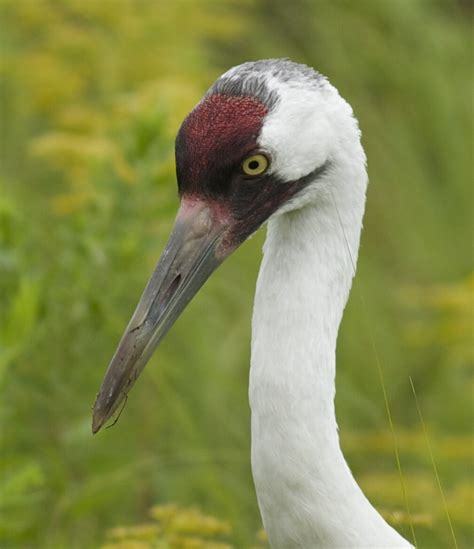

LOOK AT THAT AND TELL ME THEYRE NOT SO CUTE???

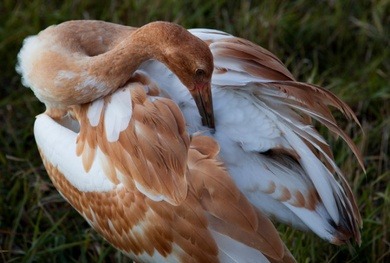
Appearance:
You can identify adult Whooping Cranes by their white feathers and patch of red on their head, which goes from their beaks to their cheeks! This patch of red is actually skin and isn't very feathery. They have long, pointed beaks, usually a gray color as you see above. They have yellow eyes and long, thin legs. I've also seen that these cranes often have the tips of their wings black.
Immature cranes have the same long beak and thin legs, but instead of white feathers, have a tan, cinnamon-brown coloring and no red spot. As they age, their white feathers come in, so the more brown feathers they have, the younger they are.
Did I mention that Whooping Cranes are really big? Because Whooping Cranes are BIG
The average height of these guys is approximately five feet (range of 4'1" to 5'3" from what I've seen) when they stand up straight, making them the biggest birds in North America. Their wingspan is 7.5 feet on average, though despite their massive height and wingspan, Whooping Cranes weigh roughly 15 pounds.
Habitat:
Whooping Cranes live in marshes, wetlands, fields, anywhere wet and grassy. They breed in the upper Midwest and around northwest Canada, and migrate south to the Gulf Coast, around Mexico.
I should also mention that Whooping Cranes are very endangered as a species. In the 1940s, due to overhunting and habitat loss, there was once only 21 Whooping Cranes alive—15 migrate birds in Canada/Texas, and 6 that lived year-round in Louisiana.
With human intervention, the species has now risen to a population of roughly 800 (I found an exact number of 836, but can't speak for its accuracy).
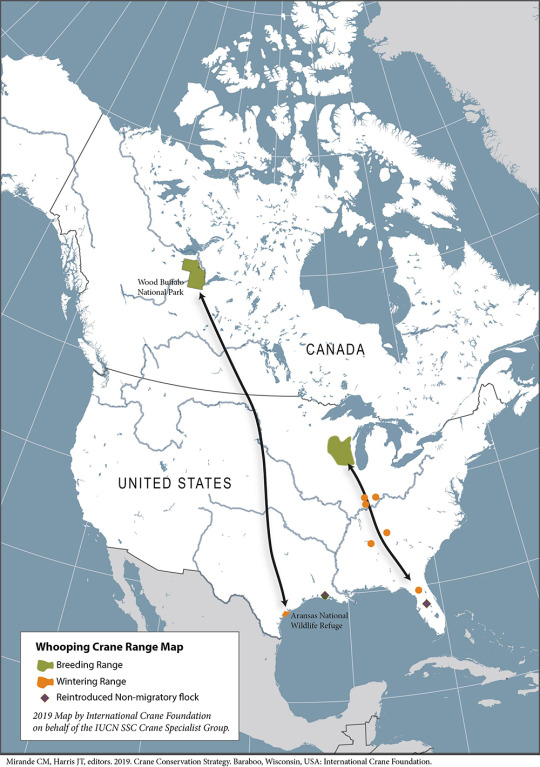
Here's a migration map I took of off savingcranes.org (please visit them, they're so cool)
Diet:
Whoopers (I saw someone call them that) ate omnivores, eating a mix of insects, amphibians, crustaceans, reptiles, and small fish and mammals. They'll also eat grain, marsh plants, plant tubers, and acorns.
Fun Facts:
Whooping Cranes' call sounds like a squeaky door. People will try to tell you it's this majestic, one-note mating call, but it is a door hinge that needs some WD-40. Here's a few videos on what they sound like :)
( https://youtu.be/NFzkXdZjQJM
https://youtu.be/8EobJR_jkjs )
Because of how Whooping Cranes almost went extinct, biologists had used aircrafts to teach young cranes how to migrate. (Here's an article on it: https://www.npr.org/2016/03/02/468045219/to-make-a-wild-comeback-cranes-need-more-than-flying-lessons)
They mate for life! They search for a mate at around 2-3 years, and then mate for life. They'll also continuously return to the same nesting and wintering territories. However, should their original mate die, they'll find another mate.
It's late, otherwise I would do more😭
Sources:
https://www.audubon.org/field-guide/bird/whooping-crane
https://savingcranes.org/learn/species-field-guide/whooping-crane/
https://www.nwf.org/Educational-Resources/Wildlife-Guide/Birds/Whooping-Crane
https://www.allaboutbirds.org/guide/Whooping_Crane/?_gl=1*10vkxuh*_ga*OTQ5Mjc2MzYyLjE2ODg1NDEwODY.*_ga_QR4NVXZ8BM*MTY4ODU0MTA5NS4xLjEuMTY4ODU0MTEyNC4zMS4wLjA.&_ga=2.29534207.1501623720.1688541086-949276362.1688541086
https://abcbirds.org/bird/whooping-crane/
I highly recommend checking these sites out, not just for Whooping Cranes, but for other birds.
3 notes
·
View notes
Text
BOTD: Great Kiskadee

Photo: Becky Matsubara
"Named for its ringing kis-ka-dee calls, this bird seems to break the rules for the flycatcher family. Besides flying out to catch insects in the air, it also grabs lizards from tree trunks, eats many berries, and even plunges into ponds to catch small fish. Its bright pattern is unique in North America, but in the tropics there are several other flycatchers that look almost identical. The Great Kiskadee is found from Texas to Argentina, and is also very common in Bermuda, where it was introduced in the 1950s."
- Audubon Field Guide
#birds#great kiskadee#birds of north america#north american birds#kiskadees#flycatchers#tyrant flycatchers#passerines#birds of mexico#birds of central america#birds of the us#birding#bird watching#birdblr#birblr#bird of the day#Pitangus sulphuratus
30 notes
·
View notes
Photo

[Image Description: A brown dragonfly perches on a flower stem. It’s wings are orange with large spots of dark brown. End ID.]
A male Halloween Pennant (Celithemis eponina) I saw in early August. This species is one of eight in it’s genus, commonly known as Pennants. According to the Kaufman Field Guide to Insects of North America, this common name is in reference to how the species are “often perched at the tip of a weed stalk, waving in the breeze like a pennant.”
#wildlife#nature#entomology#bugblr#bugs#killy killy#Kestrels Observation#zoology#biology#ecology#insects#dragonfly#dragonflies#wildlife photography#nature photography#original photography#inaturalist#insecta#odonata
16 notes
·
View notes